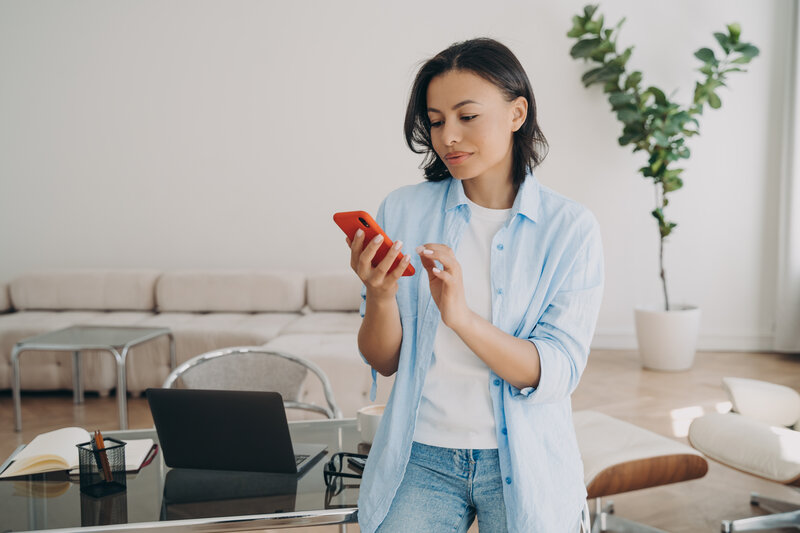Posted by: Atlantic Eye Institute in Education

Are you taking advantage of the eye health apps and tools designed to support vision health? If not, we have seven recommendations depending on your needs.
7 Eye Health Apps & Tools to Improve Eye and Vision Health
The following seven eye health apps are a good place to start. But, of course, every patient’s needs are different. Your optometrist or ophthalmologist is the best resource for learning more about apps specific to you.
My Fitness Pal
Your eye and vision health directly correlates to physical health. In fact, poor nutrition and unhealthy lifestyle choices increase your risk of developing eye conditions causing vision loss, such as diabetic retinopathy, age-related macular degeneration (AMD), and glaucoma. That’s why the first one on the list of eye health apps is My Fitness Pal.
If you don’t already use a health or fitness app, this a great, overall health app designed to support patient nutrition and weight management goals. Eating well, exercising regularly, and managing your weight set the foundation for healthy eyes and better vision.
Virtual Vision Test
There is no substitute for a comprehensive annual eye exam. However, there are times when a prescription changes in-between visits. If you suspect your eyes are changing, the Virtual Vision Test app is worth an upload. This five-minute vision test can let you know whether to upgrade your eyeglasses or contact lens prescription.
The app puts you in touch with optometrists, BUT we don’t recommend going that route. A five-minute phone test is not anything like a genuine eye exam. If the verdict is that you likely need an update, schedule an appointment with us, and we’ll make sure the prescription you walk away with is 100% correct, saving you the eye strain associated with wearing the wrong prescription!
Amblyopia Lazy Eye Exercises
This app is designed for patients who have a lazy eye (amblyopia) or crossed eyes (strabismus). Both involve weak eye muscles and poor communication/coordination between the eyes and the optic nerve. It’s best to correct them within the first five years of life, as this is when the eye/brain connection is still developing. However, it’s never too late.
The exercises in the Amblyopia Lazy Eye app continue strengthening muscles and eye coordination more affordably than professional vision therapy. This app can be used by children four years old and older and adults who want to improve strength, movement, and focus in weak eyes.
Eye Reliever
Do you spend the majority of your day working on a screen? If so, you have an elevated risk of eye strain and dry eye. We always advocate the 20-20-20 rule for children and adults during screen time, which means every 20 minutes, you spend at least 20 seconds gazing at things at least 20 feet away in the distance. It’s also important to blink more frequently during that “vision break.”
That’s easier said than done, which is where Eye Reliever comes into the picture. Start the app every time you go online. Every 20 minutes, the app alerts you that it’s time to take a vision break. We recommend capitalizing on that break to do some 5-minute office exercises or stretches to further support overall health and well-being.
Glasses Off
Eye exercises can’t do anything to change anatomical eye abnormalities or changes, but they can support eye muscle strength, function, and coordination. The Glasses Off app was developed by a team of eye specialists and neuroscientists to help near vision, preventing the need for reading glasses as long as possible.
The app explains that there is no way to completely improve certain age-related vision changes. However, optimizing eye strength is proven to help farsighted people improve their near vision range for short periods. So, for example, adhering to the app’s program may allow you to keep reading glasses in your pocket or purse to read a menu or a label on a grocery store item. In most cases, users requiring reading glasses still need them for longer reading stints or fine print.
Tap to See
The last two apps on our list are dedicated to those with more advanced or complete vision loss. The first of these is called Tap to See. This app uses the user’s smartphone camera to take a picture or film what it is they aren’t sure about. The app recognizes the item and then speaks back what it “sees.”
The user double-taps the right side of the screen to take a picture or double-taps the left side of the screen to take a video. TapTapSee can accurately analyze and identify any two or three-dimensional object at any angle within seconds. The device’s VoiceOver then speaks the identification aloud. So, for example, it might read “flower pot” or “red mug.”
Cash Reader
United States currency is not user-friendly for the visually impaired. Unlike other countries that use different-sized paper bills and different colors, our bills are all exactly the same size, color, and shape regardless of their value. This poses a challenge for visually impaired children and adults, especially if they’re legally blind.
The Cash Reader app reads money values aloud. And it’s not limited to the U.S. Cash reader accurately detects currencies from virtually every country in the world. In situations where spoken values aren’t the best or most secure option, the app has a vibrate option, and users can detect denominations based on their unique vibration patterns. Best of all, Cash Reader works just as well offline as it does online, so no internet connection is required once users successfully download the app.
Connect With Atlantic Eye Institute For More Eye Health Apps & Tools
Are you interested in learning more about the eye health apps and tools that manage vision health? Contact Atlantic Eye Institute, and we’ll let you know which apps make the most sense for you.



